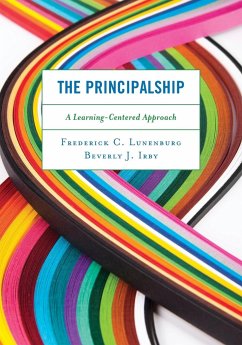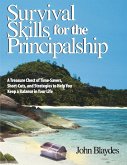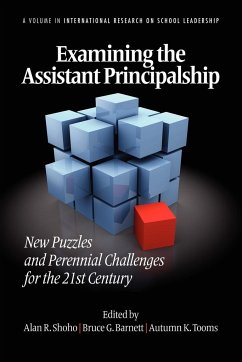- Broschiertes Buch
- Merkliste
- Auf die Merkliste
- Bewerten Bewerten
- Teilen
- Produkt teilen
- Produkterinnerung
- Produkterinnerung
The Principalship: A Learning-Centered Approach is a one-of-a kind textbook written especially for principals to help them understand current theories of teaching and learning and best leadership practices as well as practical application of these theories.
Andere Kunden interessierten sich auch für
![The New Principal The New Principal]() Margaret CarterThe New Principal61,99 €
Margaret CarterThe New Principal61,99 €![The New Principal The New Principal]() Margaret CarterThe New Principal34,99 €
Margaret CarterThe New Principal34,99 €![Survival Skills for the Principalship Survival Skills for the Principalship]() John BlaydesSurvival Skills for the Principalship41,99 €
John BlaydesSurvival Skills for the Principalship41,99 €![Examining the Assistant Principalship Examining the Assistant Principalship]() Examining the Assistant Principalship59,99 €
Examining the Assistant Principalship59,99 €![Why the Principalship? Why the Principalship?]() Dale L. BrubakerWhy the Principalship?45,99 €
Dale L. BrubakerWhy the Principalship?45,99 €![The Principalship from A to Z The Principalship from A to Z]() Ronald WilliamsonThe Principalship from A to Z119,99 €
Ronald WilliamsonThe Principalship from A to Z119,99 €![Rooms of the Mind Rooms of the Mind]() Ed D. Terry M. BrownRooms of the Mind12,99 €
Ed D. Terry M. BrownRooms of the Mind12,99 €-
-
-
The Principalship: A Learning-Centered Approach is a one-of-a kind textbook written especially for principals to help them understand current theories of teaching and learning and best leadership practices as well as practical application of these theories.
Hinweis: Dieser Artikel kann nur an eine deutsche Lieferadresse ausgeliefert werden.
Hinweis: Dieser Artikel kann nur an eine deutsche Lieferadresse ausgeliefert werden.
Produktdetails
- Produktdetails
- Verlag: Rowman & Littlefield Publishers
- Seitenzahl: 760
- Erscheinungstermin: 4. August 2022
- Englisch
- Abmessung: 254mm x 178mm x 40mm
- Gewicht: 1402g
- ISBN-13: 9781538123959
- ISBN-10: 1538123959
- Artikelnr.: 59990038
- Herstellerkennzeichnung
- Libri GmbH
- Europaallee 1
- 36244 Bad Hersfeld
- gpsr@libri.de
- Verlag: Rowman & Littlefield Publishers
- Seitenzahl: 760
- Erscheinungstermin: 4. August 2022
- Englisch
- Abmessung: 254mm x 178mm x 40mm
- Gewicht: 1402g
- ISBN-13: 9781538123959
- ISBN-10: 1538123959
- Artikelnr.: 59990038
- Herstellerkennzeichnung
- Libri GmbH
- Europaallee 1
- 36244 Bad Hersfeld
- gpsr@libri.de
Frederick C. Lunenburg is Jimmy N. Merchant Professor of Education at Sam Houston State University. Previously, he was on the faculty of educational administration at the University of Louisville, Loyola University Chicago, and Southern Utah University, where he also served as Dean of the College of Education. In addition, he has held public school positions as high school English teacher and reading specialist, high school principal, and superintendent of schools. Dr. Lunenburg's scholarship includes 48 books, 21 book chapters, and over 200 articles published in both practitioner and academic/research journals. Beverly J. Irby is Associate Dean for Academic Affairs, Regents Professor, and Marilyn Kent Byrne Endowed Chair for Student Success at Texas A & M University, College Station, Texas. In addition, she serves as Director of the Educational Leadership Research Center at Texas A & M University. She is editor of the following research journals: Mentoring and Tutoring, Advancing Women in Leadership, Dual Language and Practice, and Education Policy Briefs. She is Principal Investigator: SEED Grant (APLUS) and OELA Grants (PAL and MOOPIL). Dr. Irby has written numerous books, research reports, and articles, many of which have been presented at regional, national, and international meetings.
TABLE OF CONTENTS (DRAFT)
NOTE: We plan to change the title and issue this as a first edition because
the TOC and manuscript will be quite different from the first edition,
essentially making this a new text. We will test titles with our reviewers
and customers as part of our market development efforts. We will test the
proposed TOC along with various feature sets with customers as part of our
combined content development and market development efforts. Our efforts
will be focused on take-aways from Ubben/Hughes and potentially
Crow/Matthews. We also plan to develop some featured content that is
similar to the professional principalship books that sell into the market,
giving our text some practical flair to balance out the excellent theory
and research base. All of this will be tested with customers throughout the
development phase to see what works.
Chapter 1 Creating a Vision for Learning
Focusing Questions
Creating a Vision
The Principal's Vision
Beliefs, Values, and Attitudes
The Leadership Framework
Benefits of Articulating the Vision
Shepherding the Vision
Vision Detractors
Vision Maintainers
Creating a Professional Learning Community
Creating a Mission Statement
Developing a Vision
Developing Value Statements
Establishing Goals
Goal Statements
Hierarchy of Goals
Criteria for Effective Goals
The Goal-Setting Process
Problems with Goal Setting
Making Goal Setting Effective
Developing Plans for Attaining Goals
Strategic Plans
Tactical Plans
Operational Plans
Standing Plans
Single-Use Plans
How Some Schools Have Used Goal-Setting to Improve Test Scores
Developing a Culture for Learning
Definition and Characteristics
Heroes, Traditions, and Networks
Maintaining School Culture
The Principal as Instructional Leader
Focusing on Learning
Encouraging Collaboration
Analyzing Results
Providing Support
Aligning Curriculum, Instruction, and Assessment
Summary
Chapter 2. The Curriculum
Focusing Questions
Concepts and Models of Curriculum
Tyler: Classical Model
Beauchamp: Managerial Model
Taba: Applicative Model
Saylor and Colleagues: Systems Model
Eisner: Dimensional Model
Ornstein: Systemic Model
Irby and Lunenburg: Aligned Model
Relationship of Curriculum to Instruction
The Principal as Curriculum Leader
Building a Community of Learners
Curriculum Goals and Instructional Objectives
Writing Effective Instructional Objectives
Developing a Needs Assessment
Conducting a Needs Assessment
Incorporating Standards
Selecting Assessment Tools
Developing a Curriculum Alignment Process
Focusing the Vision on the School's Mission through Curriculum
Aligning the Curriculum to the Vision and Mission
Summary
Chapter 3 Teaching and Learning
Focusing Questions
The Principal's Role in Teaching and Learning
The Principal's Role in Instructional Planning
Promoting Teacher Reflection
Using Student Data in Instructional Planning
Using Students' Cultural Background in Instructional Planning
Ethnoinstruction
Differentiated Instruction
Using Theoretical Frames for Instructional Planning
Gagne: Conditions of Learning
Guilford: Structure of Intellect
Kohlberg: Stages of Moral Development
Rosenshine and Meister: Scaffolding
Piaget: Stages of Intellectual Development
Dunn and Dunn: Learning Styles
Gardner: Multiple Intelligences
The Effective Schools Model
Clear and Focused Mission
Instructional Leadership
High Expectations
Opportunity to learn and Time on Task
Frequent Monitoring
Safe and Orderly Environment
Positive Home-School Environment
Effective Teaching Practices
Twelve Practices of Effective Teaching
Conditions for Learning
Best Practices for the Classroom
Models of Evaluation
Formative and Summative
Clinical Supervision
Walk-Through Observations
Peer Coaching
Summary
Chapter 4 Professional Development to Improve Learning
The Principal's Mission Related to Professional Development
The Principal's Mission for Teacher's Professional Development
High Quality Professional Development
Ten Principles of Effective Professional Development
Action Research
Evaluation Portfolio
The Principals Mission for Personal Professional Development
The Professional Development Portfolio
Using the Professional Development Portfolio
Ethics of Professional Development
National Staff Development Council Code of Ethics
Summary
Chapter 5 Directing Student Services
Focusing Questions
Guidance and Counseling Services
Aims
Role of the Counselor
Major Services
Methods of Counseling
Evaluation of Counseling Services
Attendance and Student Records
Use of Assessment Data to Improve Learning
Reporting to Parents and Families
Methods of Reporting Student Progress
Extracurricular Programs and Athletics
Goals
Functions
Special Education Services
Related Services
Due Process Protections
Discipline
Gifted Education
Definitions of Giftedness
Administrative Arrangements
Curriculum Models
Bilingual Education
Program Descriptions
Administrative Arrangements
Bilingual Education Models
English as a Second Language
Summary
Chapter 6 Organizational Structure and Design
Focusing Questions
Schools as Open Systems
Inputs
Transformation Process
Outputs
Feedback
Leadership Functions
Planning
Organizing
Leading
Monitoring
Effective Principals
Task Dimensions
Human Resource Activities
Behavioral Profiles of Effective Principals
The Demise of Bureaucracy
Emergent Models of Organizational Structure
System 4 Design
Site-Based Management
Transformational Leadership
Group Dynamics and Teams
Synergistic Leadership Theory
Summary
Chapter 7 Decision Making: Individual and Group Processes
Focusing Questions
The Nature of Decision Making
Types of Decisions
How are Decisions Made?
Individual Influences on Decision Making
The Role of Intuition in Decision Making
Creativity in Decision Making
Stages in the Creative Process
Characteristics of Creative People
Conditions Necessary to Stimulate Creativity
Enhancing Creativity
Creativity Training
Decision-Making Styles
Directive
Analytical
Conceptual
Behavioral
Group Decision Making
Benefits of Group Decision Making
Decision Quality
Decision Creativity
Decision Acceptance
Decision Judgment
Decision Accuracy
Problems with Group Decision Making
Groupthink
Risky Shift
Escalation of Commitment
Techniques for Improving Group Decisions
Brainstorming
Nominal Group Technique
Delphi Technique
Devil's Advocacy
Dialectical Inquiry
Group Behavior
Stages of Group Development
Forming
Storming
Norming
Performing
Adjourning
Characteristics of Mature Groups
Group Roles
Group Norms
Group Status
Group Size
Group Cohesiveness
Summary
Chapter 8 Developing Effective Communications
Focusing Questions
The Importance of Communication
Functions of Communication
Directing Action
Linking and Coordinating
Building Relationships
Learning Organizational Culture
Presenting a School's Image
Generating Ideas
Promoting Ideals and Values
Fostering Motivation
Providing Information
The Communication Process
Develop an Idea
Encode
Transmit
Receive
Decode
Accept
Use
Feedback
Verbal Communication: Speaking and Writing
Nonverbal Communication
Kinesics
Proxemics
Paralanguage
Chronemics
Practical Tips
Formal Communication Channels
Downward Communication
Upward Communication
Horizontal Communication
Diagonal Communication
Informal Communication Channels
The Grapevine
Rumor
How to Combat Rumors
Communication Networks
Network Patterns
Network Analysis
Barriers to Communication
Frames of Reference
Sender Credibility
Filtering
Selective Perceptions
Structure
Information Overload
Semantics
Status Differences
Gender Differences
Cultural Context
Ethnocentrism
"Poilitically Correct" Communication
Overcoming Barriers to Communication
Communicating in Diverse Organizations
Repetition
Empathy
Understanding
Feedback
Regulating Information Flow
Simplifying Language
Encouraging Mutual Trust
Adapting Communication Styles
Active Listening
Technology and Communication
Electronic Mail (E-mail)
Instant Messaging
Social Networking
Voice Mail
Personal Digital Assistants and Smartphones
Blogs (Web Logs)
Presentation Technology
Videoconferencing
Choosing Media: A Contingency Approach
Persuasive Communication
Summary
Chapter 9 Change and Stress Management
Focusing Questions
The Nature of Organizational Change
Forces for Change
Resistance to Change
Overcoming Resistance to Change
Approaches to Managing Change
Lewin's Three-Step Model
Kotter's Eight-Step Model
Harris's Five-Phase Model
Greiner's Pattern of Change Model
Organizational Development Interventions
Total Quality Management
Strategic Planning
Survey Feedback
Appreciative Inquiry
Job Enrichment
Behavioral Performance Management
Work Stress and Its Management
Sources of Stress
Effects of Stress
Coping with Stress
Summary
Chapter 10 Budgeting and School Facilities Management
Focusing Questions
School Budgeting
Expenditures
Revenue
The Budgeting Process
Line-Item Budgeting
Zero-Based Budgeting
Planning-Programming Budgeting Systems
Financial Controls
Internal Control
Financial Audits
School Facilities Management
School Infrastructure Costs
Financing School Construction
Asbestos
Radon Gas
School Lead
Indoor Air Quality
Electromagnetic Fields
Summary
Chapter 11 Creating Safe Schools
School Safety
Understanding School Violence
Research on School Crime and Student Safety
Violent Deaths at School
Nonfatal Victimization-Student Reports
School Environment-Crime Incidents
Bullying
Disrespect for Teachers
Gang Activities
Illegal Drugs
Hate-Related Words
Fights, Weapons, and Illegal Substances
Fear and Avoidance
Discipline, Safety, and Security Measures
Causes of School Violence
Access to Weapons
Media Violence
Cyber Abuse
Environmental Impact
Improving School Safety
Physical Surveillance
Weapons Deterrence
Campus Police Officers
School Policies
Instructional Programs
Profiling Potentially Violent Students
Counseling and Mediation
Research on Alcohol and Drug Use Among Adolescents
Alcohol
Tobacco and E-Cigarettes
Illicit Drugs
Marijuana
Prescription and Over-the-Counter Drugs
Other Illicit Drugs
Inhalants
Risk of Future Addiction Disorder
Importance of Relationships with Parents
Applying Research to Practice: Developing an Action Plan
Strategy 1: Predict School Violence
Strategy 2: Prevent School Violence
Strategy 3: Focus Resources on Schools
Strategy 4: Strengthen the System
Strategy 5: Develop a Crisis Management Plan
Strategy 6: Create an Orderly Climate for Learning
Summary
Chapter 12 Human Resources Management
Focusing Questions
Recruitment
Job Analysis
Legal Constraints
Personnel Sources
Teacher Recruitment Consortium
Selection
Interviews
Components of a Good Interview Process
Testing
Assessment Centers
Professional Development
Assessing Professional Development Needs
Setting Professional Development Objectives
Selecting Professional Development Methods
Evaluating the Professional Development Program
Orientation and Induction of the Beginning Teacher
Performance Appraisal
Appraisal Methods
Common Rating Errors
Other Appraisal Methods
Supervision and Evaluation
Improving Teacher Performance Appraisals
Union-Management Relations
Bargaining Issues
The Bargaining Process
Bargaining Tactics
New Bargaining Strategies
Summary
Chapter 13 Community Relations
Focusing Questions
Principals as "Boundary Spanners"
School, Family, and Community Involvement
Principals Leading Community Efforts during Catastrophes
Principals Leading school, Family, and Community Involvement
More Family Involvement Information for Principals to Consider
The Harvard Family Engagement Model
School-Community Relations and Public relations
The Politics of Internal and External Publics
Consideration of the Media and Community Relations
NSPRA Standards for Educational Public Relations Programs
Public Relations Plan
The Four-Step Public Relations Process
Public relations Planning Process
Summary
Chapter 14 The Principal and Ethics
Focusing Questions
The Ethical Principal
Principals and Philosophical Concepts of Ethics
Rights
Freedom
Responsibility and Authority
Duty
Justice
Equity
Caring
Character, Commitment, and Formality
Loyalty
Prudence
Critique
Profession
Moral Imperative
Principals and Ethical Behavior in Schools
Principals Promoting Ethical Behavior in Athletic Programs
Principals Promoting Ethical Behavior through Character education
Politics and Procedures That Promote Ethical Beha Ethics for Principals
National and State Codes for Principals
National Ethical Codes
State Codes
Summary
Chapter 15 Political and Policy Context
Focusing Questions
Society, Policy, and Politics
Policy, Politics, and the Principal
What is a Policy?
The Examination of Policy
Conceptual Framework for Understanding Policy
What is Meant by Politics?
Types of Educational Politics
Politics in the District
Working with the Superintendent and other External Forces
Summary
Chapter 16 The Principal and Legal Issues
Focusing Questions
Legal Framework for Public Education
Federal Level
The Federal Constitution
Federal Statutes
Federal Administrative Agencies
Case Law
State Level
State Constitutions
State Statutes
State Administrative Agencies
Local Level
The American Judicial System
Federal Courts
State Courts
Church-State Relations
Prayer and Bible Reading
Distribution of Religious Literature
Released Time for Religious Instruction
Religious Absences
State Aid to Private Schools
Aid to Encourage Educational Choice
Attendance and Instructional Issues
Compulsory School Attendance
The School Curriculum
Student Proficiency Testing
School Fees
Students' Rights
Freedom of Expression
Student Appearance
Student Discipline
Classification Practices
Rights of Students with Disabilities
A History of Neglect
Section 504 of the Rehabilitation Act of 1975
Individuals with Disabilities Education Act
Teachers' Rights
Licensure and Certification
Contracts
Termination of Employment
Discrimination in Employment
Tort Liability
Definition of a Tort
Intentional Interference
Elements of Negligence
Defenses against Negligence
Collective Bargaining
Scope of Bargaining
Bargaining Issues
The Bargaining Process
Bargaining Tactics
New Bargaining Strategies
Local School Districts and School Boards
Powers of Local School Boards
School Board Membership
School Board Procedures
School Elections
School Finance
Local Financing of Public Schools
Challenges to State Finance Systems
Spending versus Outcomes
State Financing of Public Schools
State Financial Responsibility
School Finance Trends
Summary
References
Name Index
Subject Index
NOTE: We plan to change the title and issue this as a first edition because
the TOC and manuscript will be quite different from the first edition,
essentially making this a new text. We will test titles with our reviewers
and customers as part of our market development efforts. We will test the
proposed TOC along with various feature sets with customers as part of our
combined content development and market development efforts. Our efforts
will be focused on take-aways from Ubben/Hughes and potentially
Crow/Matthews. We also plan to develop some featured content that is
similar to the professional principalship books that sell into the market,
giving our text some practical flair to balance out the excellent theory
and research base. All of this will be tested with customers throughout the
development phase to see what works.
Chapter 1 Creating a Vision for Learning
Focusing Questions
Creating a Vision
The Principal's Vision
Beliefs, Values, and Attitudes
The Leadership Framework
Benefits of Articulating the Vision
Shepherding the Vision
Vision Detractors
Vision Maintainers
Creating a Professional Learning Community
Creating a Mission Statement
Developing a Vision
Developing Value Statements
Establishing Goals
Goal Statements
Hierarchy of Goals
Criteria for Effective Goals
The Goal-Setting Process
Problems with Goal Setting
Making Goal Setting Effective
Developing Plans for Attaining Goals
Strategic Plans
Tactical Plans
Operational Plans
Standing Plans
Single-Use Plans
How Some Schools Have Used Goal-Setting to Improve Test Scores
Developing a Culture for Learning
Definition and Characteristics
Heroes, Traditions, and Networks
Maintaining School Culture
The Principal as Instructional Leader
Focusing on Learning
Encouraging Collaboration
Analyzing Results
Providing Support
Aligning Curriculum, Instruction, and Assessment
Summary
Chapter 2. The Curriculum
Focusing Questions
Concepts and Models of Curriculum
Tyler: Classical Model
Beauchamp: Managerial Model
Taba: Applicative Model
Saylor and Colleagues: Systems Model
Eisner: Dimensional Model
Ornstein: Systemic Model
Irby and Lunenburg: Aligned Model
Relationship of Curriculum to Instruction
The Principal as Curriculum Leader
Building a Community of Learners
Curriculum Goals and Instructional Objectives
Writing Effective Instructional Objectives
Developing a Needs Assessment
Conducting a Needs Assessment
Incorporating Standards
Selecting Assessment Tools
Developing a Curriculum Alignment Process
Focusing the Vision on the School's Mission through Curriculum
Aligning the Curriculum to the Vision and Mission
Summary
Chapter 3 Teaching and Learning
Focusing Questions
The Principal's Role in Teaching and Learning
The Principal's Role in Instructional Planning
Promoting Teacher Reflection
Using Student Data in Instructional Planning
Using Students' Cultural Background in Instructional Planning
Ethnoinstruction
Differentiated Instruction
Using Theoretical Frames for Instructional Planning
Gagne: Conditions of Learning
Guilford: Structure of Intellect
Kohlberg: Stages of Moral Development
Rosenshine and Meister: Scaffolding
Piaget: Stages of Intellectual Development
Dunn and Dunn: Learning Styles
Gardner: Multiple Intelligences
The Effective Schools Model
Clear and Focused Mission
Instructional Leadership
High Expectations
Opportunity to learn and Time on Task
Frequent Monitoring
Safe and Orderly Environment
Positive Home-School Environment
Effective Teaching Practices
Twelve Practices of Effective Teaching
Conditions for Learning
Best Practices for the Classroom
Models of Evaluation
Formative and Summative
Clinical Supervision
Walk-Through Observations
Peer Coaching
Summary
Chapter 4 Professional Development to Improve Learning
The Principal's Mission Related to Professional Development
The Principal's Mission for Teacher's Professional Development
High Quality Professional Development
Ten Principles of Effective Professional Development
Action Research
Evaluation Portfolio
The Principals Mission for Personal Professional Development
The Professional Development Portfolio
Using the Professional Development Portfolio
Ethics of Professional Development
National Staff Development Council Code of Ethics
Summary
Chapter 5 Directing Student Services
Focusing Questions
Guidance and Counseling Services
Aims
Role of the Counselor
Major Services
Methods of Counseling
Evaluation of Counseling Services
Attendance and Student Records
Use of Assessment Data to Improve Learning
Reporting to Parents and Families
Methods of Reporting Student Progress
Extracurricular Programs and Athletics
Goals
Functions
Special Education Services
Related Services
Due Process Protections
Discipline
Gifted Education
Definitions of Giftedness
Administrative Arrangements
Curriculum Models
Bilingual Education
Program Descriptions
Administrative Arrangements
Bilingual Education Models
English as a Second Language
Summary
Chapter 6 Organizational Structure and Design
Focusing Questions
Schools as Open Systems
Inputs
Transformation Process
Outputs
Feedback
Leadership Functions
Planning
Organizing
Leading
Monitoring
Effective Principals
Task Dimensions
Human Resource Activities
Behavioral Profiles of Effective Principals
The Demise of Bureaucracy
Emergent Models of Organizational Structure
System 4 Design
Site-Based Management
Transformational Leadership
Group Dynamics and Teams
Synergistic Leadership Theory
Summary
Chapter 7 Decision Making: Individual and Group Processes
Focusing Questions
The Nature of Decision Making
Types of Decisions
How are Decisions Made?
Individual Influences on Decision Making
The Role of Intuition in Decision Making
Creativity in Decision Making
Stages in the Creative Process
Characteristics of Creative People
Conditions Necessary to Stimulate Creativity
Enhancing Creativity
Creativity Training
Decision-Making Styles
Directive
Analytical
Conceptual
Behavioral
Group Decision Making
Benefits of Group Decision Making
Decision Quality
Decision Creativity
Decision Acceptance
Decision Judgment
Decision Accuracy
Problems with Group Decision Making
Groupthink
Risky Shift
Escalation of Commitment
Techniques for Improving Group Decisions
Brainstorming
Nominal Group Technique
Delphi Technique
Devil's Advocacy
Dialectical Inquiry
Group Behavior
Stages of Group Development
Forming
Storming
Norming
Performing
Adjourning
Characteristics of Mature Groups
Group Roles
Group Norms
Group Status
Group Size
Group Cohesiveness
Summary
Chapter 8 Developing Effective Communications
Focusing Questions
The Importance of Communication
Functions of Communication
Directing Action
Linking and Coordinating
Building Relationships
Learning Organizational Culture
Presenting a School's Image
Generating Ideas
Promoting Ideals and Values
Fostering Motivation
Providing Information
The Communication Process
Develop an Idea
Encode
Transmit
Receive
Decode
Accept
Use
Feedback
Verbal Communication: Speaking and Writing
Nonverbal Communication
Kinesics
Proxemics
Paralanguage
Chronemics
Practical Tips
Formal Communication Channels
Downward Communication
Upward Communication
Horizontal Communication
Diagonal Communication
Informal Communication Channels
The Grapevine
Rumor
How to Combat Rumors
Communication Networks
Network Patterns
Network Analysis
Barriers to Communication
Frames of Reference
Sender Credibility
Filtering
Selective Perceptions
Structure
Information Overload
Semantics
Status Differences
Gender Differences
Cultural Context
Ethnocentrism
"Poilitically Correct" Communication
Overcoming Barriers to Communication
Communicating in Diverse Organizations
Repetition
Empathy
Understanding
Feedback
Regulating Information Flow
Simplifying Language
Encouraging Mutual Trust
Adapting Communication Styles
Active Listening
Technology and Communication
Electronic Mail (E-mail)
Instant Messaging
Social Networking
Voice Mail
Personal Digital Assistants and Smartphones
Blogs (Web Logs)
Presentation Technology
Videoconferencing
Choosing Media: A Contingency Approach
Persuasive Communication
Summary
Chapter 9 Change and Stress Management
Focusing Questions
The Nature of Organizational Change
Forces for Change
Resistance to Change
Overcoming Resistance to Change
Approaches to Managing Change
Lewin's Three-Step Model
Kotter's Eight-Step Model
Harris's Five-Phase Model
Greiner's Pattern of Change Model
Organizational Development Interventions
Total Quality Management
Strategic Planning
Survey Feedback
Appreciative Inquiry
Job Enrichment
Behavioral Performance Management
Work Stress and Its Management
Sources of Stress
Effects of Stress
Coping with Stress
Summary
Chapter 10 Budgeting and School Facilities Management
Focusing Questions
School Budgeting
Expenditures
Revenue
The Budgeting Process
Line-Item Budgeting
Zero-Based Budgeting
Planning-Programming Budgeting Systems
Financial Controls
Internal Control
Financial Audits
School Facilities Management
School Infrastructure Costs
Financing School Construction
Asbestos
Radon Gas
School Lead
Indoor Air Quality
Electromagnetic Fields
Summary
Chapter 11 Creating Safe Schools
School Safety
Understanding School Violence
Research on School Crime and Student Safety
Violent Deaths at School
Nonfatal Victimization-Student Reports
School Environment-Crime Incidents
Bullying
Disrespect for Teachers
Gang Activities
Illegal Drugs
Hate-Related Words
Fights, Weapons, and Illegal Substances
Fear and Avoidance
Discipline, Safety, and Security Measures
Causes of School Violence
Access to Weapons
Media Violence
Cyber Abuse
Environmental Impact
Improving School Safety
Physical Surveillance
Weapons Deterrence
Campus Police Officers
School Policies
Instructional Programs
Profiling Potentially Violent Students
Counseling and Mediation
Research on Alcohol and Drug Use Among Adolescents
Alcohol
Tobacco and E-Cigarettes
Illicit Drugs
Marijuana
Prescription and Over-the-Counter Drugs
Other Illicit Drugs
Inhalants
Risk of Future Addiction Disorder
Importance of Relationships with Parents
Applying Research to Practice: Developing an Action Plan
Strategy 1: Predict School Violence
Strategy 2: Prevent School Violence
Strategy 3: Focus Resources on Schools
Strategy 4: Strengthen the System
Strategy 5: Develop a Crisis Management Plan
Strategy 6: Create an Orderly Climate for Learning
Summary
Chapter 12 Human Resources Management
Focusing Questions
Recruitment
Job Analysis
Legal Constraints
Personnel Sources
Teacher Recruitment Consortium
Selection
Interviews
Components of a Good Interview Process
Testing
Assessment Centers
Professional Development
Assessing Professional Development Needs
Setting Professional Development Objectives
Selecting Professional Development Methods
Evaluating the Professional Development Program
Orientation and Induction of the Beginning Teacher
Performance Appraisal
Appraisal Methods
Common Rating Errors
Other Appraisal Methods
Supervision and Evaluation
Improving Teacher Performance Appraisals
Union-Management Relations
Bargaining Issues
The Bargaining Process
Bargaining Tactics
New Bargaining Strategies
Summary
Chapter 13 Community Relations
Focusing Questions
Principals as "Boundary Spanners"
School, Family, and Community Involvement
Principals Leading Community Efforts during Catastrophes
Principals Leading school, Family, and Community Involvement
More Family Involvement Information for Principals to Consider
The Harvard Family Engagement Model
School-Community Relations and Public relations
The Politics of Internal and External Publics
Consideration of the Media and Community Relations
NSPRA Standards for Educational Public Relations Programs
Public Relations Plan
The Four-Step Public Relations Process
Public relations Planning Process
Summary
Chapter 14 The Principal and Ethics
Focusing Questions
The Ethical Principal
Principals and Philosophical Concepts of Ethics
Rights
Freedom
Responsibility and Authority
Duty
Justice
Equity
Caring
Character, Commitment, and Formality
Loyalty
Prudence
Critique
Profession
Moral Imperative
Principals and Ethical Behavior in Schools
Principals Promoting Ethical Behavior in Athletic Programs
Principals Promoting Ethical Behavior through Character education
Politics and Procedures That Promote Ethical Beha Ethics for Principals
National and State Codes for Principals
National Ethical Codes
State Codes
Summary
Chapter 15 Political and Policy Context
Focusing Questions
Society, Policy, and Politics
Policy, Politics, and the Principal
What is a Policy?
The Examination of Policy
Conceptual Framework for Understanding Policy
What is Meant by Politics?
Types of Educational Politics
Politics in the District
Working with the Superintendent and other External Forces
Summary
Chapter 16 The Principal and Legal Issues
Focusing Questions
Legal Framework for Public Education
Federal Level
The Federal Constitution
Federal Statutes
Federal Administrative Agencies
Case Law
State Level
State Constitutions
State Statutes
State Administrative Agencies
Local Level
The American Judicial System
Federal Courts
State Courts
Church-State Relations
Prayer and Bible Reading
Distribution of Religious Literature
Released Time for Religious Instruction
Religious Absences
State Aid to Private Schools
Aid to Encourage Educational Choice
Attendance and Instructional Issues
Compulsory School Attendance
The School Curriculum
Student Proficiency Testing
School Fees
Students' Rights
Freedom of Expression
Student Appearance
Student Discipline
Classification Practices
Rights of Students with Disabilities
A History of Neglect
Section 504 of the Rehabilitation Act of 1975
Individuals with Disabilities Education Act
Teachers' Rights
Licensure and Certification
Contracts
Termination of Employment
Discrimination in Employment
Tort Liability
Definition of a Tort
Intentional Interference
Elements of Negligence
Defenses against Negligence
Collective Bargaining
Scope of Bargaining
Bargaining Issues
The Bargaining Process
Bargaining Tactics
New Bargaining Strategies
Local School Districts and School Boards
Powers of Local School Boards
School Board Membership
School Board Procedures
School Elections
School Finance
Local Financing of Public Schools
Challenges to State Finance Systems
Spending versus Outcomes
State Financing of Public Schools
State Financial Responsibility
School Finance Trends
Summary
References
Name Index
Subject Index
TABLE OF CONTENTS (DRAFT)
NOTE: We plan to change the title and issue this as a first edition because
the TOC and manuscript will be quite different from the first edition,
essentially making this a new text. We will test titles with our reviewers
and customers as part of our market development efforts. We will test the
proposed TOC along with various feature sets with customers as part of our
combined content development and market development efforts. Our efforts
will be focused on take-aways from Ubben/Hughes and potentially
Crow/Matthews. We also plan to develop some featured content that is
similar to the professional principalship books that sell into the market,
giving our text some practical flair to balance out the excellent theory
and research base. All of this will be tested with customers throughout the
development phase to see what works.
Chapter 1 Creating a Vision for Learning
Focusing Questions
Creating a Vision
The Principal's Vision
Beliefs, Values, and Attitudes
The Leadership Framework
Benefits of Articulating the Vision
Shepherding the Vision
Vision Detractors
Vision Maintainers
Creating a Professional Learning Community
Creating a Mission Statement
Developing a Vision
Developing Value Statements
Establishing Goals
Goal Statements
Hierarchy of Goals
Criteria for Effective Goals
The Goal-Setting Process
Problems with Goal Setting
Making Goal Setting Effective
Developing Plans for Attaining Goals
Strategic Plans
Tactical Plans
Operational Plans
Standing Plans
Single-Use Plans
How Some Schools Have Used Goal-Setting to Improve Test Scores
Developing a Culture for Learning
Definition and Characteristics
Heroes, Traditions, and Networks
Maintaining School Culture
The Principal as Instructional Leader
Focusing on Learning
Encouraging Collaboration
Analyzing Results
Providing Support
Aligning Curriculum, Instruction, and Assessment
Summary
Chapter 2. The Curriculum
Focusing Questions
Concepts and Models of Curriculum
Tyler: Classical Model
Beauchamp: Managerial Model
Taba: Applicative Model
Saylor and Colleagues: Systems Model
Eisner: Dimensional Model
Ornstein: Systemic Model
Irby and Lunenburg: Aligned Model
Relationship of Curriculum to Instruction
The Principal as Curriculum Leader
Building a Community of Learners
Curriculum Goals and Instructional Objectives
Writing Effective Instructional Objectives
Developing a Needs Assessment
Conducting a Needs Assessment
Incorporating Standards
Selecting Assessment Tools
Developing a Curriculum Alignment Process
Focusing the Vision on the School's Mission through Curriculum
Aligning the Curriculum to the Vision and Mission
Summary
Chapter 3 Teaching and Learning
Focusing Questions
The Principal's Role in Teaching and Learning
The Principal's Role in Instructional Planning
Promoting Teacher Reflection
Using Student Data in Instructional Planning
Using Students' Cultural Background in Instructional Planning
Ethnoinstruction
Differentiated Instruction
Using Theoretical Frames for Instructional Planning
Gagne: Conditions of Learning
Guilford: Structure of Intellect
Kohlberg: Stages of Moral Development
Rosenshine and Meister: Scaffolding
Piaget: Stages of Intellectual Development
Dunn and Dunn: Learning Styles
Gardner: Multiple Intelligences
The Effective Schools Model
Clear and Focused Mission
Instructional Leadership
High Expectations
Opportunity to learn and Time on Task
Frequent Monitoring
Safe and Orderly Environment
Positive Home-School Environment
Effective Teaching Practices
Twelve Practices of Effective Teaching
Conditions for Learning
Best Practices for the Classroom
Models of Evaluation
Formative and Summative
Clinical Supervision
Walk-Through Observations
Peer Coaching
Summary
Chapter 4 Professional Development to Improve Learning
The Principal's Mission Related to Professional Development
The Principal's Mission for Teacher's Professional Development
High Quality Professional Development
Ten Principles of Effective Professional Development
Action Research
Evaluation Portfolio
The Principals Mission for Personal Professional Development
The Professional Development Portfolio
Using the Professional Development Portfolio
Ethics of Professional Development
National Staff Development Council Code of Ethics
Summary
Chapter 5 Directing Student Services
Focusing Questions
Guidance and Counseling Services
Aims
Role of the Counselor
Major Services
Methods of Counseling
Evaluation of Counseling Services
Attendance and Student Records
Use of Assessment Data to Improve Learning
Reporting to Parents and Families
Methods of Reporting Student Progress
Extracurricular Programs and Athletics
Goals
Functions
Special Education Services
Related Services
Due Process Protections
Discipline
Gifted Education
Definitions of Giftedness
Administrative Arrangements
Curriculum Models
Bilingual Education
Program Descriptions
Administrative Arrangements
Bilingual Education Models
English as a Second Language
Summary
Chapter 6 Organizational Structure and Design
Focusing Questions
Schools as Open Systems
Inputs
Transformation Process
Outputs
Feedback
Leadership Functions
Planning
Organizing
Leading
Monitoring
Effective Principals
Task Dimensions
Human Resource Activities
Behavioral Profiles of Effective Principals
The Demise of Bureaucracy
Emergent Models of Organizational Structure
System 4 Design
Site-Based Management
Transformational Leadership
Group Dynamics and Teams
Synergistic Leadership Theory
Summary
Chapter 7 Decision Making: Individual and Group Processes
Focusing Questions
The Nature of Decision Making
Types of Decisions
How are Decisions Made?
Individual Influences on Decision Making
The Role of Intuition in Decision Making
Creativity in Decision Making
Stages in the Creative Process
Characteristics of Creative People
Conditions Necessary to Stimulate Creativity
Enhancing Creativity
Creativity Training
Decision-Making Styles
Directive
Analytical
Conceptual
Behavioral
Group Decision Making
Benefits of Group Decision Making
Decision Quality
Decision Creativity
Decision Acceptance
Decision Judgment
Decision Accuracy
Problems with Group Decision Making
Groupthink
Risky Shift
Escalation of Commitment
Techniques for Improving Group Decisions
Brainstorming
Nominal Group Technique
Delphi Technique
Devil's Advocacy
Dialectical Inquiry
Group Behavior
Stages of Group Development
Forming
Storming
Norming
Performing
Adjourning
Characteristics of Mature Groups
Group Roles
Group Norms
Group Status
Group Size
Group Cohesiveness
Summary
Chapter 8 Developing Effective Communications
Focusing Questions
The Importance of Communication
Functions of Communication
Directing Action
Linking and Coordinating
Building Relationships
Learning Organizational Culture
Presenting a School's Image
Generating Ideas
Promoting Ideals and Values
Fostering Motivation
Providing Information
The Communication Process
Develop an Idea
Encode
Transmit
Receive
Decode
Accept
Use
Feedback
Verbal Communication: Speaking and Writing
Nonverbal Communication
Kinesics
Proxemics
Paralanguage
Chronemics
Practical Tips
Formal Communication Channels
Downward Communication
Upward Communication
Horizontal Communication
Diagonal Communication
Informal Communication Channels
The Grapevine
Rumor
How to Combat Rumors
Communication Networks
Network Patterns
Network Analysis
Barriers to Communication
Frames of Reference
Sender Credibility
Filtering
Selective Perceptions
Structure
Information Overload
Semantics
Status Differences
Gender Differences
Cultural Context
Ethnocentrism
"Poilitically Correct" Communication
Overcoming Barriers to Communication
Communicating in Diverse Organizations
Repetition
Empathy
Understanding
Feedback
Regulating Information Flow
Simplifying Language
Encouraging Mutual Trust
Adapting Communication Styles
Active Listening
Technology and Communication
Electronic Mail (E-mail)
Instant Messaging
Social Networking
Voice Mail
Personal Digital Assistants and Smartphones
Blogs (Web Logs)
Presentation Technology
Videoconferencing
Choosing Media: A Contingency Approach
Persuasive Communication
Summary
Chapter 9 Change and Stress Management
Focusing Questions
The Nature of Organizational Change
Forces for Change
Resistance to Change
Overcoming Resistance to Change
Approaches to Managing Change
Lewin's Three-Step Model
Kotter's Eight-Step Model
Harris's Five-Phase Model
Greiner's Pattern of Change Model
Organizational Development Interventions
Total Quality Management
Strategic Planning
Survey Feedback
Appreciative Inquiry
Job Enrichment
Behavioral Performance Management
Work Stress and Its Management
Sources of Stress
Effects of Stress
Coping with Stress
Summary
Chapter 10 Budgeting and School Facilities Management
Focusing Questions
School Budgeting
Expenditures
Revenue
The Budgeting Process
Line-Item Budgeting
Zero-Based Budgeting
Planning-Programming Budgeting Systems
Financial Controls
Internal Control
Financial Audits
School Facilities Management
School Infrastructure Costs
Financing School Construction
Asbestos
Radon Gas
School Lead
Indoor Air Quality
Electromagnetic Fields
Summary
Chapter 11 Creating Safe Schools
School Safety
Understanding School Violence
Research on School Crime and Student Safety
Violent Deaths at School
Nonfatal Victimization-Student Reports
School Environment-Crime Incidents
Bullying
Disrespect for Teachers
Gang Activities
Illegal Drugs
Hate-Related Words
Fights, Weapons, and Illegal Substances
Fear and Avoidance
Discipline, Safety, and Security Measures
Causes of School Violence
Access to Weapons
Media Violence
Cyber Abuse
Environmental Impact
Improving School Safety
Physical Surveillance
Weapons Deterrence
Campus Police Officers
School Policies
Instructional Programs
Profiling Potentially Violent Students
Counseling and Mediation
Research on Alcohol and Drug Use Among Adolescents
Alcohol
Tobacco and E-Cigarettes
Illicit Drugs
Marijuana
Prescription and Over-the-Counter Drugs
Other Illicit Drugs
Inhalants
Risk of Future Addiction Disorder
Importance of Relationships with Parents
Applying Research to Practice: Developing an Action Plan
Strategy 1: Predict School Violence
Strategy 2: Prevent School Violence
Strategy 3: Focus Resources on Schools
Strategy 4: Strengthen the System
Strategy 5: Develop a Crisis Management Plan
Strategy 6: Create an Orderly Climate for Learning
Summary
Chapter 12 Human Resources Management
Focusing Questions
Recruitment
Job Analysis
Legal Constraints
Personnel Sources
Teacher Recruitment Consortium
Selection
Interviews
Components of a Good Interview Process
Testing
Assessment Centers
Professional Development
Assessing Professional Development Needs
Setting Professional Development Objectives
Selecting Professional Development Methods
Evaluating the Professional Development Program
Orientation and Induction of the Beginning Teacher
Performance Appraisal
Appraisal Methods
Common Rating Errors
Other Appraisal Methods
Supervision and Evaluation
Improving Teacher Performance Appraisals
Union-Management Relations
Bargaining Issues
The Bargaining Process
Bargaining Tactics
New Bargaining Strategies
Summary
Chapter 13 Community Relations
Focusing Questions
Principals as "Boundary Spanners"
School, Family, and Community Involvement
Principals Leading Community Efforts during Catastrophes
Principals Leading school, Family, and Community Involvement
More Family Involvement Information for Principals to Consider
The Harvard Family Engagement Model
School-Community Relations and Public relations
The Politics of Internal and External Publics
Consideration of the Media and Community Relations
NSPRA Standards for Educational Public Relations Programs
Public Relations Plan
The Four-Step Public Relations Process
Public relations Planning Process
Summary
Chapter 14 The Principal and Ethics
Focusing Questions
The Ethical Principal
Principals and Philosophical Concepts of Ethics
Rights
Freedom
Responsibility and Authority
Duty
Justice
Equity
Caring
Character, Commitment, and Formality
Loyalty
Prudence
Critique
Profession
Moral Imperative
Principals and Ethical Behavior in Schools
Principals Promoting Ethical Behavior in Athletic Programs
Principals Promoting Ethical Behavior through Character education
Politics and Procedures That Promote Ethical Beha Ethics for Principals
National and State Codes for Principals
National Ethical Codes
State Codes
Summary
Chapter 15 Political and Policy Context
Focusing Questions
Society, Policy, and Politics
Policy, Politics, and the Principal
What is a Policy?
The Examination of Policy
Conceptual Framework for Understanding Policy
What is Meant by Politics?
Types of Educational Politics
Politics in the District
Working with the Superintendent and other External Forces
Summary
Chapter 16 The Principal and Legal Issues
Focusing Questions
Legal Framework for Public Education
Federal Level
The Federal Constitution
Federal Statutes
Federal Administrative Agencies
Case Law
State Level
State Constitutions
State Statutes
State Administrative Agencies
Local Level
The American Judicial System
Federal Courts
State Courts
Church-State Relations
Prayer and Bible Reading
Distribution of Religious Literature
Released Time for Religious Instruction
Religious Absences
State Aid to Private Schools
Aid to Encourage Educational Choice
Attendance and Instructional Issues
Compulsory School Attendance
The School Curriculum
Student Proficiency Testing
School Fees
Students' Rights
Freedom of Expression
Student Appearance
Student Discipline
Classification Practices
Rights of Students with Disabilities
A History of Neglect
Section 504 of the Rehabilitation Act of 1975
Individuals with Disabilities Education Act
Teachers' Rights
Licensure and Certification
Contracts
Termination of Employment
Discrimination in Employment
Tort Liability
Definition of a Tort
Intentional Interference
Elements of Negligence
Defenses against Negligence
Collective Bargaining
Scope of Bargaining
Bargaining Issues
The Bargaining Process
Bargaining Tactics
New Bargaining Strategies
Local School Districts and School Boards
Powers of Local School Boards
School Board Membership
School Board Procedures
School Elections
School Finance
Local Financing of Public Schools
Challenges to State Finance Systems
Spending versus Outcomes
State Financing of Public Schools
State Financial Responsibility
School Finance Trends
Summary
References
Name Index
Subject Index
NOTE: We plan to change the title and issue this as a first edition because
the TOC and manuscript will be quite different from the first edition,
essentially making this a new text. We will test titles with our reviewers
and customers as part of our market development efforts. We will test the
proposed TOC along with various feature sets with customers as part of our
combined content development and market development efforts. Our efforts
will be focused on take-aways from Ubben/Hughes and potentially
Crow/Matthews. We also plan to develop some featured content that is
similar to the professional principalship books that sell into the market,
giving our text some practical flair to balance out the excellent theory
and research base. All of this will be tested with customers throughout the
development phase to see what works.
Chapter 1 Creating a Vision for Learning
Focusing Questions
Creating a Vision
The Principal's Vision
Beliefs, Values, and Attitudes
The Leadership Framework
Benefits of Articulating the Vision
Shepherding the Vision
Vision Detractors
Vision Maintainers
Creating a Professional Learning Community
Creating a Mission Statement
Developing a Vision
Developing Value Statements
Establishing Goals
Goal Statements
Hierarchy of Goals
Criteria for Effective Goals
The Goal-Setting Process
Problems with Goal Setting
Making Goal Setting Effective
Developing Plans for Attaining Goals
Strategic Plans
Tactical Plans
Operational Plans
Standing Plans
Single-Use Plans
How Some Schools Have Used Goal-Setting to Improve Test Scores
Developing a Culture for Learning
Definition and Characteristics
Heroes, Traditions, and Networks
Maintaining School Culture
The Principal as Instructional Leader
Focusing on Learning
Encouraging Collaboration
Analyzing Results
Providing Support
Aligning Curriculum, Instruction, and Assessment
Summary
Chapter 2. The Curriculum
Focusing Questions
Concepts and Models of Curriculum
Tyler: Classical Model
Beauchamp: Managerial Model
Taba: Applicative Model
Saylor and Colleagues: Systems Model
Eisner: Dimensional Model
Ornstein: Systemic Model
Irby and Lunenburg: Aligned Model
Relationship of Curriculum to Instruction
The Principal as Curriculum Leader
Building a Community of Learners
Curriculum Goals and Instructional Objectives
Writing Effective Instructional Objectives
Developing a Needs Assessment
Conducting a Needs Assessment
Incorporating Standards
Selecting Assessment Tools
Developing a Curriculum Alignment Process
Focusing the Vision on the School's Mission through Curriculum
Aligning the Curriculum to the Vision and Mission
Summary
Chapter 3 Teaching and Learning
Focusing Questions
The Principal's Role in Teaching and Learning
The Principal's Role in Instructional Planning
Promoting Teacher Reflection
Using Student Data in Instructional Planning
Using Students' Cultural Background in Instructional Planning
Ethnoinstruction
Differentiated Instruction
Using Theoretical Frames for Instructional Planning
Gagne: Conditions of Learning
Guilford: Structure of Intellect
Kohlberg: Stages of Moral Development
Rosenshine and Meister: Scaffolding
Piaget: Stages of Intellectual Development
Dunn and Dunn: Learning Styles
Gardner: Multiple Intelligences
The Effective Schools Model
Clear and Focused Mission
Instructional Leadership
High Expectations
Opportunity to learn and Time on Task
Frequent Monitoring
Safe and Orderly Environment
Positive Home-School Environment
Effective Teaching Practices
Twelve Practices of Effective Teaching
Conditions for Learning
Best Practices for the Classroom
Models of Evaluation
Formative and Summative
Clinical Supervision
Walk-Through Observations
Peer Coaching
Summary
Chapter 4 Professional Development to Improve Learning
The Principal's Mission Related to Professional Development
The Principal's Mission for Teacher's Professional Development
High Quality Professional Development
Ten Principles of Effective Professional Development
Action Research
Evaluation Portfolio
The Principals Mission for Personal Professional Development
The Professional Development Portfolio
Using the Professional Development Portfolio
Ethics of Professional Development
National Staff Development Council Code of Ethics
Summary
Chapter 5 Directing Student Services
Focusing Questions
Guidance and Counseling Services
Aims
Role of the Counselor
Major Services
Methods of Counseling
Evaluation of Counseling Services
Attendance and Student Records
Use of Assessment Data to Improve Learning
Reporting to Parents and Families
Methods of Reporting Student Progress
Extracurricular Programs and Athletics
Goals
Functions
Special Education Services
Related Services
Due Process Protections
Discipline
Gifted Education
Definitions of Giftedness
Administrative Arrangements
Curriculum Models
Bilingual Education
Program Descriptions
Administrative Arrangements
Bilingual Education Models
English as a Second Language
Summary
Chapter 6 Organizational Structure and Design
Focusing Questions
Schools as Open Systems
Inputs
Transformation Process
Outputs
Feedback
Leadership Functions
Planning
Organizing
Leading
Monitoring
Effective Principals
Task Dimensions
Human Resource Activities
Behavioral Profiles of Effective Principals
The Demise of Bureaucracy
Emergent Models of Organizational Structure
System 4 Design
Site-Based Management
Transformational Leadership
Group Dynamics and Teams
Synergistic Leadership Theory
Summary
Chapter 7 Decision Making: Individual and Group Processes
Focusing Questions
The Nature of Decision Making
Types of Decisions
How are Decisions Made?
Individual Influences on Decision Making
The Role of Intuition in Decision Making
Creativity in Decision Making
Stages in the Creative Process
Characteristics of Creative People
Conditions Necessary to Stimulate Creativity
Enhancing Creativity
Creativity Training
Decision-Making Styles
Directive
Analytical
Conceptual
Behavioral
Group Decision Making
Benefits of Group Decision Making
Decision Quality
Decision Creativity
Decision Acceptance
Decision Judgment
Decision Accuracy
Problems with Group Decision Making
Groupthink
Risky Shift
Escalation of Commitment
Techniques for Improving Group Decisions
Brainstorming
Nominal Group Technique
Delphi Technique
Devil's Advocacy
Dialectical Inquiry
Group Behavior
Stages of Group Development
Forming
Storming
Norming
Performing
Adjourning
Characteristics of Mature Groups
Group Roles
Group Norms
Group Status
Group Size
Group Cohesiveness
Summary
Chapter 8 Developing Effective Communications
Focusing Questions
The Importance of Communication
Functions of Communication
Directing Action
Linking and Coordinating
Building Relationships
Learning Organizational Culture
Presenting a School's Image
Generating Ideas
Promoting Ideals and Values
Fostering Motivation
Providing Information
The Communication Process
Develop an Idea
Encode
Transmit
Receive
Decode
Accept
Use
Feedback
Verbal Communication: Speaking and Writing
Nonverbal Communication
Kinesics
Proxemics
Paralanguage
Chronemics
Practical Tips
Formal Communication Channels
Downward Communication
Upward Communication
Horizontal Communication
Diagonal Communication
Informal Communication Channels
The Grapevine
Rumor
How to Combat Rumors
Communication Networks
Network Patterns
Network Analysis
Barriers to Communication
Frames of Reference
Sender Credibility
Filtering
Selective Perceptions
Structure
Information Overload
Semantics
Status Differences
Gender Differences
Cultural Context
Ethnocentrism
"Poilitically Correct" Communication
Overcoming Barriers to Communication
Communicating in Diverse Organizations
Repetition
Empathy
Understanding
Feedback
Regulating Information Flow
Simplifying Language
Encouraging Mutual Trust
Adapting Communication Styles
Active Listening
Technology and Communication
Electronic Mail (E-mail)
Instant Messaging
Social Networking
Voice Mail
Personal Digital Assistants and Smartphones
Blogs (Web Logs)
Presentation Technology
Videoconferencing
Choosing Media: A Contingency Approach
Persuasive Communication
Summary
Chapter 9 Change and Stress Management
Focusing Questions
The Nature of Organizational Change
Forces for Change
Resistance to Change
Overcoming Resistance to Change
Approaches to Managing Change
Lewin's Three-Step Model
Kotter's Eight-Step Model
Harris's Five-Phase Model
Greiner's Pattern of Change Model
Organizational Development Interventions
Total Quality Management
Strategic Planning
Survey Feedback
Appreciative Inquiry
Job Enrichment
Behavioral Performance Management
Work Stress and Its Management
Sources of Stress
Effects of Stress
Coping with Stress
Summary
Chapter 10 Budgeting and School Facilities Management
Focusing Questions
School Budgeting
Expenditures
Revenue
The Budgeting Process
Line-Item Budgeting
Zero-Based Budgeting
Planning-Programming Budgeting Systems
Financial Controls
Internal Control
Financial Audits
School Facilities Management
School Infrastructure Costs
Financing School Construction
Asbestos
Radon Gas
School Lead
Indoor Air Quality
Electromagnetic Fields
Summary
Chapter 11 Creating Safe Schools
School Safety
Understanding School Violence
Research on School Crime and Student Safety
Violent Deaths at School
Nonfatal Victimization-Student Reports
School Environment-Crime Incidents
Bullying
Disrespect for Teachers
Gang Activities
Illegal Drugs
Hate-Related Words
Fights, Weapons, and Illegal Substances
Fear and Avoidance
Discipline, Safety, and Security Measures
Causes of School Violence
Access to Weapons
Media Violence
Cyber Abuse
Environmental Impact
Improving School Safety
Physical Surveillance
Weapons Deterrence
Campus Police Officers
School Policies
Instructional Programs
Profiling Potentially Violent Students
Counseling and Mediation
Research on Alcohol and Drug Use Among Adolescents
Alcohol
Tobacco and E-Cigarettes
Illicit Drugs
Marijuana
Prescription and Over-the-Counter Drugs
Other Illicit Drugs
Inhalants
Risk of Future Addiction Disorder
Importance of Relationships with Parents
Applying Research to Practice: Developing an Action Plan
Strategy 1: Predict School Violence
Strategy 2: Prevent School Violence
Strategy 3: Focus Resources on Schools
Strategy 4: Strengthen the System
Strategy 5: Develop a Crisis Management Plan
Strategy 6: Create an Orderly Climate for Learning
Summary
Chapter 12 Human Resources Management
Focusing Questions
Recruitment
Job Analysis
Legal Constraints
Personnel Sources
Teacher Recruitment Consortium
Selection
Interviews
Components of a Good Interview Process
Testing
Assessment Centers
Professional Development
Assessing Professional Development Needs
Setting Professional Development Objectives
Selecting Professional Development Methods
Evaluating the Professional Development Program
Orientation and Induction of the Beginning Teacher
Performance Appraisal
Appraisal Methods
Common Rating Errors
Other Appraisal Methods
Supervision and Evaluation
Improving Teacher Performance Appraisals
Union-Management Relations
Bargaining Issues
The Bargaining Process
Bargaining Tactics
New Bargaining Strategies
Summary
Chapter 13 Community Relations
Focusing Questions
Principals as "Boundary Spanners"
School, Family, and Community Involvement
Principals Leading Community Efforts during Catastrophes
Principals Leading school, Family, and Community Involvement
More Family Involvement Information for Principals to Consider
The Harvard Family Engagement Model
School-Community Relations and Public relations
The Politics of Internal and External Publics
Consideration of the Media and Community Relations
NSPRA Standards for Educational Public Relations Programs
Public Relations Plan
The Four-Step Public Relations Process
Public relations Planning Process
Summary
Chapter 14 The Principal and Ethics
Focusing Questions
The Ethical Principal
Principals and Philosophical Concepts of Ethics
Rights
Freedom
Responsibility and Authority
Duty
Justice
Equity
Caring
Character, Commitment, and Formality
Loyalty
Prudence
Critique
Profession
Moral Imperative
Principals and Ethical Behavior in Schools
Principals Promoting Ethical Behavior in Athletic Programs
Principals Promoting Ethical Behavior through Character education
Politics and Procedures That Promote Ethical Beha Ethics for Principals
National and State Codes for Principals
National Ethical Codes
State Codes
Summary
Chapter 15 Political and Policy Context
Focusing Questions
Society, Policy, and Politics
Policy, Politics, and the Principal
What is a Policy?
The Examination of Policy
Conceptual Framework for Understanding Policy
What is Meant by Politics?
Types of Educational Politics
Politics in the District
Working with the Superintendent and other External Forces
Summary
Chapter 16 The Principal and Legal Issues
Focusing Questions
Legal Framework for Public Education
Federal Level
The Federal Constitution
Federal Statutes
Federal Administrative Agencies
Case Law
State Level
State Constitutions
State Statutes
State Administrative Agencies
Local Level
The American Judicial System
Federal Courts
State Courts
Church-State Relations
Prayer and Bible Reading
Distribution of Religious Literature
Released Time for Religious Instruction
Religious Absences
State Aid to Private Schools
Aid to Encourage Educational Choice
Attendance and Instructional Issues
Compulsory School Attendance
The School Curriculum
Student Proficiency Testing
School Fees
Students' Rights
Freedom of Expression
Student Appearance
Student Discipline
Classification Practices
Rights of Students with Disabilities
A History of Neglect
Section 504 of the Rehabilitation Act of 1975
Individuals with Disabilities Education Act
Teachers' Rights
Licensure and Certification
Contracts
Termination of Employment
Discrimination in Employment
Tort Liability
Definition of a Tort
Intentional Interference
Elements of Negligence
Defenses against Negligence
Collective Bargaining
Scope of Bargaining
Bargaining Issues
The Bargaining Process
Bargaining Tactics
New Bargaining Strategies
Local School Districts and School Boards
Powers of Local School Boards
School Board Membership
School Board Procedures
School Elections
School Finance
Local Financing of Public Schools
Challenges to State Finance Systems
Spending versus Outcomes
State Financing of Public Schools
State Financial Responsibility
School Finance Trends
Summary
References
Name Index
Subject Index








